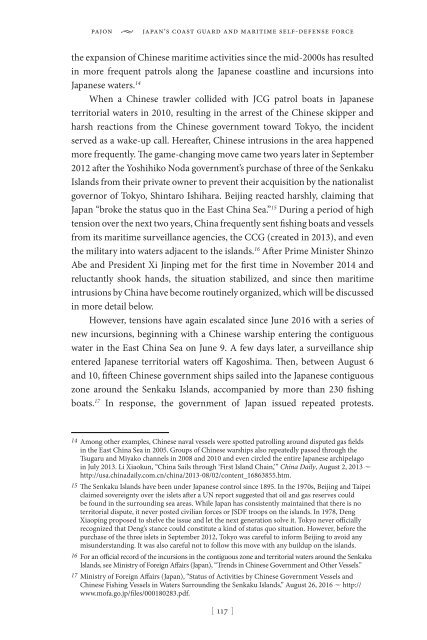2jBVKVf
2jBVKVf
2jBVKVf
Create successful ePaper yourself
Turn your PDF publications into a flip-book with our unique Google optimized e-Paper software.
pajon • japan’s coast guard and maritime self-defense force<br />
the expansion of Chinese maritime activities since the mid-2000s has resulted<br />
in more frequent patrols along the Japanese coastline and incursions into<br />
Japanese waters. 14<br />
When a Chinese trawler collided with JCG patrol boats in Japanese<br />
territorial waters in 2010, resulting in the arrest of the Chinese skipper and<br />
harsh reactions from the Chinese government toward Tokyo, the incident<br />
served as a wake-up call. Hereafter, Chinese intrusions in the area happened<br />
more frequently. The game-changing move came two years later in September<br />
2012 after the Yoshihiko Noda government’s purchase of three of the Senkaku<br />
Islands from their private owner to prevent their acquisition by the nationalist<br />
governor of Tokyo, Shintaro Ishihara. Beijing reacted harshly, claiming that<br />
Japan “broke the status quo in the East China Sea.” 15 During a period of high<br />
tension over the next two years, China frequently sent fishing boats and vessels<br />
from its maritime surveillance agencies, the CCG (created in 2013), and even<br />
the military into waters adjacent to the islands. 16 After Prime Minister Shinzo<br />
Abe and President Xi Jinping met for the first time in November 2014 and<br />
reluctantly shook hands, the situation stabilized, and since then maritime<br />
intrusions by China have become routinely organized, which will be discussed<br />
in more detail below.<br />
However, tensions have again escalated since June 2016 with a series of<br />
new incursions, beginning with a Chinese warship entering the contiguous<br />
water in the East China Sea on June 9. A few days later, a surveillance ship<br />
entered Japanese territorial waters off Kagoshima. Then, between August 6<br />
and 10, fifteen Chinese government ships sailed into the Japanese contiguous<br />
zone around the Senkaku Islands, accompanied by more than 230 fishing<br />
boats. 17 In response, the government of Japan issued repeated protests.<br />
14 Among other examples, Chinese naval vessels were spotted patrolling around disputed gas fields<br />
in the East China Sea in 2005. Groups of Chinese warships also repeatedly passed through the<br />
Tsugaru and Miyako channels in 2008 and 2010 and even circled the entire Japanese archipelago<br />
in July 2013. Li Xiaokun, “China Sails through ‘First Island Chain,’ ” China Daily, August 2, 2013 u<br />
http://usa.chinadaily.com.cn/china/2013-08/02/content_16863855.htm.<br />
15 The Senkaku Islands have been under Japanese control since 1895. In the 1970s, Beijing and Taipei<br />
claimed sovereignty over the islets after a UN report suggested that oil and gas reserves could<br />
be found in the surrounding sea areas. While Japan has consistently maintained that there is no<br />
territorial dispute, it never posted civilian forces or JSDF troops on the islands. In 1978, Deng<br />
Xiaoping proposed to shelve the issue and let the next generation solve it. Tokyo never officially<br />
recognized that Deng’s stance could constitute a kind of status quo situation. However, before the<br />
purchase of the three islets in September 2012, Tokyo was careful to inform Beijing to avoid any<br />
misunderstanding. It was also careful not to follow this move with any buildup on the islands.<br />
16 For an official record of the incursions in the contiguous zone and territorial waters around the Senkaku<br />
Islands, see Ministry of Foreign Affairs (Japan), “Trends in Chinese Government and Other Vessels.”<br />
17 Ministry of Foreign Affairs (Japan), “Status of Activities by Chinese Government Vessels and<br />
Chinese Fishing Vessels in Waters Surrounding the Senkaku Islands,” August 26, 2016 u http://<br />
www.mofa.go.jp/files/000180283.pdf.<br />
[ 117 ]


